Deep Spearfishing: all about the Variable Weight
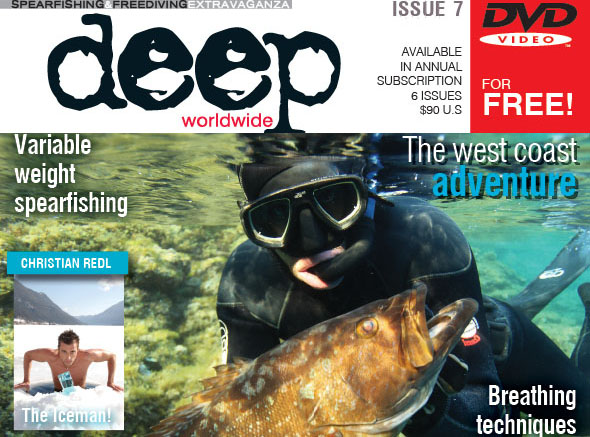 A new partnership was born between Apnea Magazine and Deep Worldwide, the bimonthly greek magazine of our friend Dimitri Kollias, about freediving and spearfishing.
A new partnership was born between Apnea Magazine and Deep Worldwide, the bimonthly greek magazine of our friend Dimitri Kollias, about freediving and spearfishing.
Starting from today, and for several months, we will publish some articles from the ellenic magazine about varoius arguments.They will be available on our website and social networks channels, both in English and Italian language. morover, by clicking on the interactive cover you will find on th top of each article, you will reach the deepww.com website. We wish you good reading!
Since old Greek sponge divers times, variable weight diving has been permanently on the agenda of free divers. Using an oval shape marble block (petra) and an attached rope; sponge divers of the past used to dive very fast, very deep, collect their stuff at that depth, and return back to surface with the help of their top men who were pulling up the line and the weight. The culture of using a pendulum has obviously developed since then. Today the historic petra has evolved into a modern diving sledge in an athletic wet arena.
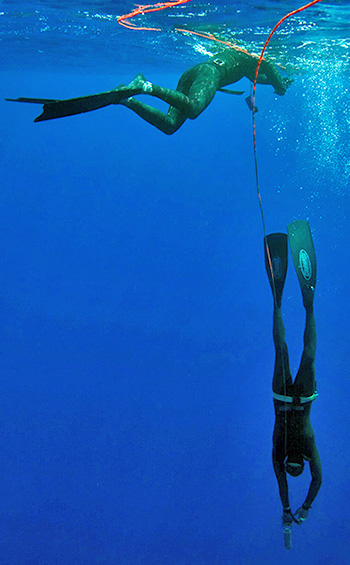 The idea of diving using a detachable weight applies perfectly to spearfishing as well. However, we should always remember that it is not a tool to reach the unreachable. Pushing the limits and exceeding them with the help of a variable weight system is only for free diving events and can be nothing but an invitation for accidents while fishing. Pendulums should not be used for depths out of reach in a constant weight dive. Variable weight is a great method for safer dives when a little more bottom time or comfort to work at depth is needed. Or it can just be for additional safety while pulling a grouper out of its cave.
The idea of diving using a detachable weight applies perfectly to spearfishing as well. However, we should always remember that it is not a tool to reach the unreachable. Pushing the limits and exceeding them with the help of a variable weight system is only for free diving events and can be nothing but an invitation for accidents while fishing. Pendulums should not be used for depths out of reach in a constant weight dive. Variable weight is a great method for safer dives when a little more bottom time or comfort to work at depth is needed. Or it can just be for additional safety while pulling a grouper out of its cave.
How should we rig a good variable weight system?
A good amount of weight, some rope, and a float is all we need while fishing with a pendulum. However, little details and tips make this tool a lot more reliable and easier to use.
Ballast weight: Depending on the purpose, season and style of fishing, one might need different caliber lead blocks. In theory, we should put only a few kilos of weight on the belt to maintain our buoyancy at the bottom, adjusting the rest of the weight as separable. While doing so, a good trick to define the amount of variable part is to start adding weight on our belt and observe the point which we start sinking on exhale.
Adjusting the weight distribution this way will give a setup in which we fin only a few times just before the descent starts.
During descent, getting relaxed is the most important part. The usual methods are: 1) a pendulum with a handle 2) a flat shaped pendulum that fits under the belt 3) a second weight belt 4) the normal weight belt with additional weight.
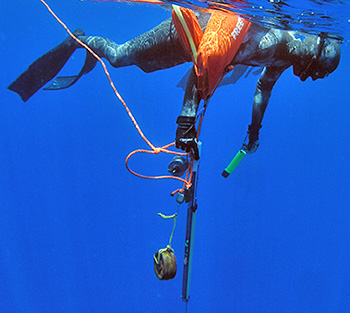 Float: Float: In 90% of the variable weight setup cases, an ordinary dive float is more than enough. Strong clips to attach the recovery line and a bright color to follow the diver are advisable. In some extreme cases though, where the weight of ballast exceeds 10kg, special attention to the float is needed as the heavy ballast can burst out the float if a short line is preferred.
Float: Float: In 90% of the variable weight setup cases, an ordinary dive float is more than enough. Strong clips to attach the recovery line and a bright color to follow the diver are advisable. In some extreme cases though, where the weight of ballast exceeds 10kg, special attention to the float is needed as the heavy ballast can burst out the float if a short line is preferred.
Float line: Recovery ropes are the crucial part of any variable weight setup. Floating ropes or air filled tubes with enough thickness are needed to prevent tangling. The thicker the line is the better, as long as the tension of the rope is not accelerating or blocking our dives. Once detached from the diver, the rope has to rise up to surface without leaving any slack at the bottom. It is not very important to have ropes with high breaking strains, but a minimum of 8mm thickness will make the recovery very fast and easy.
A short bungee at the float end of the rope will always help the diver to move freely into deeper zones without adjusting the length of the float line for every different depth/dive. Using a mono line for the last few meters of float line is suggested, in order not to scare fish. The truth is that the vibrations from the long rope are more than enough to create some distraction. However, at deeper zones fish usually behave much more calmly and you can always compensate the handicap of the recovery line.
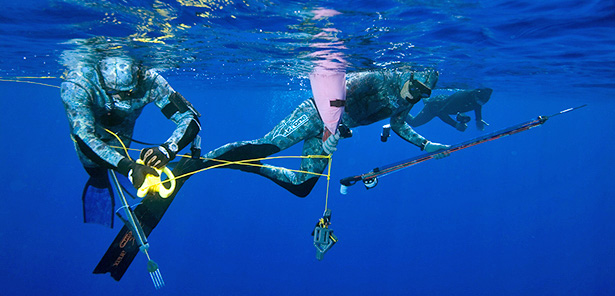
Like all methods of spearfishing, variable weight fishing requires a lot of practice and testing. Getting used to fast descents and deep dives requires some time and while doing so, we have to find the optimal rig for ourselves. Depending on the physical limits of each diver, a variable weight setup can start from a simple 2kg weight block up to a 20kg winch recovered torpedo! A diving buddy is a must in this discipline as well, while pulling the pendulum for each other lets divers concentrate more and rest properly.
TechniquesApplying the variable weight method in spearfishing, the diver has the following options: a) Carry the ballast during total bottom time and release it just before ascending. This style is required when using the “heavy belt” method and it works for easy-to-approach fish that don’t get scared from the hanging rope, or for spearing in holes. b) Leave the weight when hitting the bottom, and then crawl towards the selected spot/fish. This is a very effective method that works perfectly on drop offs. The diver leaves the weight on the top of the step and sinks gently to the target. c) Use a line shorter than the selected depth that will automatically pull and release the weight from the belt a couple of meters before the diver hits the bottom. |
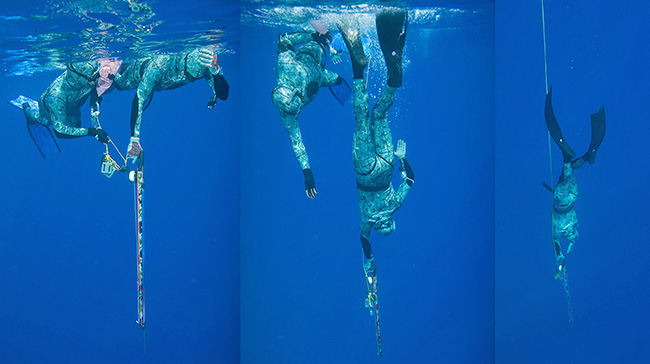
Safety
Once used within limits diving with a pendulum increases safety. Conserving more oxygen than a constant weight dive, the spear fisherman is able to focus more on fishing and safe ascends. However, there are hidden dangers associated with variable weight diving.
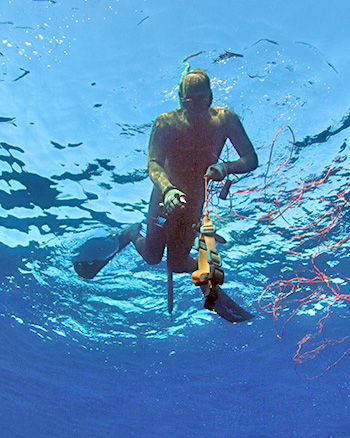 A barotrauma can easily occur as the diver descends rapidly if the sinuses are blocked or even just malfunctioning. Never dive with a cold and always equalize well. In case of a problem, just quit the dive. The sea will be there the next day too, as long as you are still able to dive.
A barotrauma can easily occur as the diver descends rapidly if the sinuses are blocked or even just malfunctioning. Never dive with a cold and always equalize well. In case of a problem, just quit the dive. The sea will be there the next day too, as long as you are still able to dive.
– Although we dive within our limits in variable weight spearfishing, never forget to do warm up sessions. At the beginning of each session we should start with stretching exercises and a few warm up dives. The human body is highly adaptable to high-pressure environments but pushing the limits without preparation can cause lung injuries and even more severe problems.
– After an easy descent as the diver feels much more relaxed and full of air at the bottom, it is usually easier to push limits. Self-awareness is the key. Even so, with a faster than normal ascent, shallow water black outs can come more suddenly. Especially at the last 10m where the diver is ascending with fastest speeds, the dive buddy has to be alert and wait until recovery breathing is over.
– While spearfishing with variable weight several decompression sickness (DCS) incidents have been reported. Deep and repetitive dives with low effort and subsequent short surface times can accumulate enough nitrogen in our tissues; fast and uncontrolled ascents trigger the main problem. Long surface intervals and fixing the number of daily deep dives to logical numbers can save us from this very dangerous situation. In competitions, inhaling oxygen after very deep dives from a tank is almost a standard practice in order to prevent DCS.
– Another complication that comes with the very deep spearfishing is nitrogen narcosis. By definition “narcosis is the temporary decline or loss of senses and movement, numbness”. In simple terms, it can be regarded as clumsiness. Loss of concentration not only makes us lose fish but also can make us use more time than necessary or could even make us tangle the float line. Unfortunately, the effects and adaptation to narcosis varies from diver to diver and there is not a general rule to avoid it. The only way to avoid this phenomenon completely however, is by not pushing the limits of spearfishing to that level.
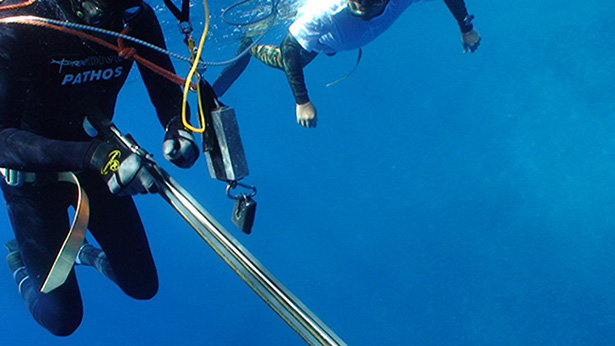
Conclusion
In today’s spearfishing competitions, we observe a lot of top athletes diving and fishing with variable weight. Legendary Spaniard, 3 time World Champion Jose Amengual, started this method three decades ago in order to overpass his handicapped leg. Later on, Alberto March, Greek champion Giannis Sideris and many other spearfishing legends have used this method to shoot fish below 40 meters of depth, and winning several podium places in the worldwide arena`. Depending on one’s physical condition, variable weight spearfishing can open a new window in fishing providing the extra seconds needed to get the trophy of your dreams. Using some extra weight on the descent is always good fun. We fin less and there is always more time with fewer thoughts on the mind. The diver is focused on relaxation and enjoys the magical gliding moments. Diving buddies can enjoy this method while recovering the pendulum from the bottom, creating a mandatory surface interval for safe diving.
Just remember: free divers use it as a tool to exceed normal limits, we use it to make our sessions safer and more comfortable.
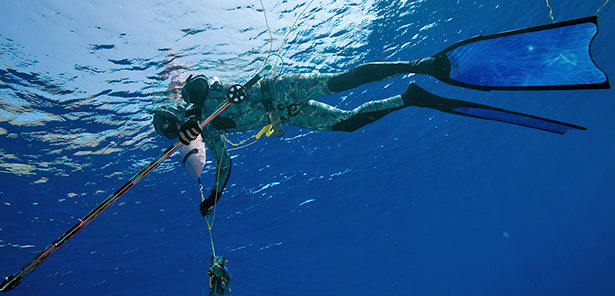
Category: English


